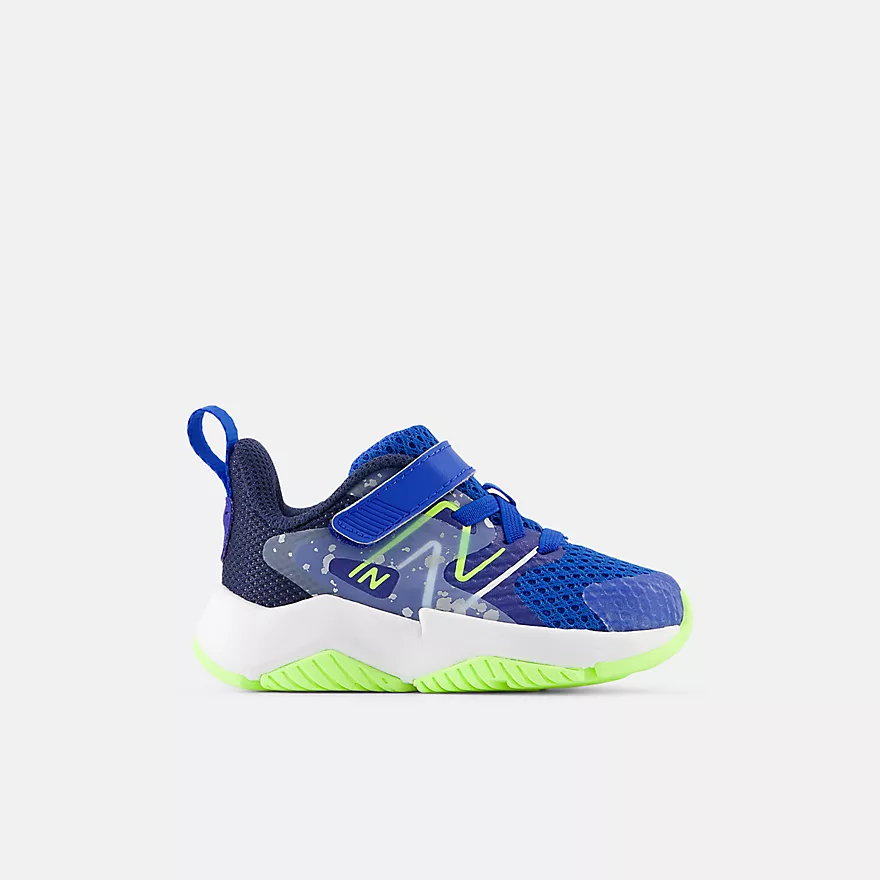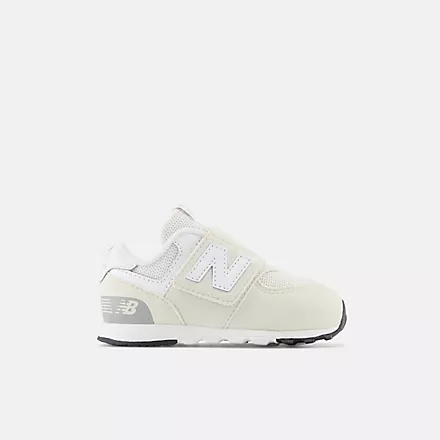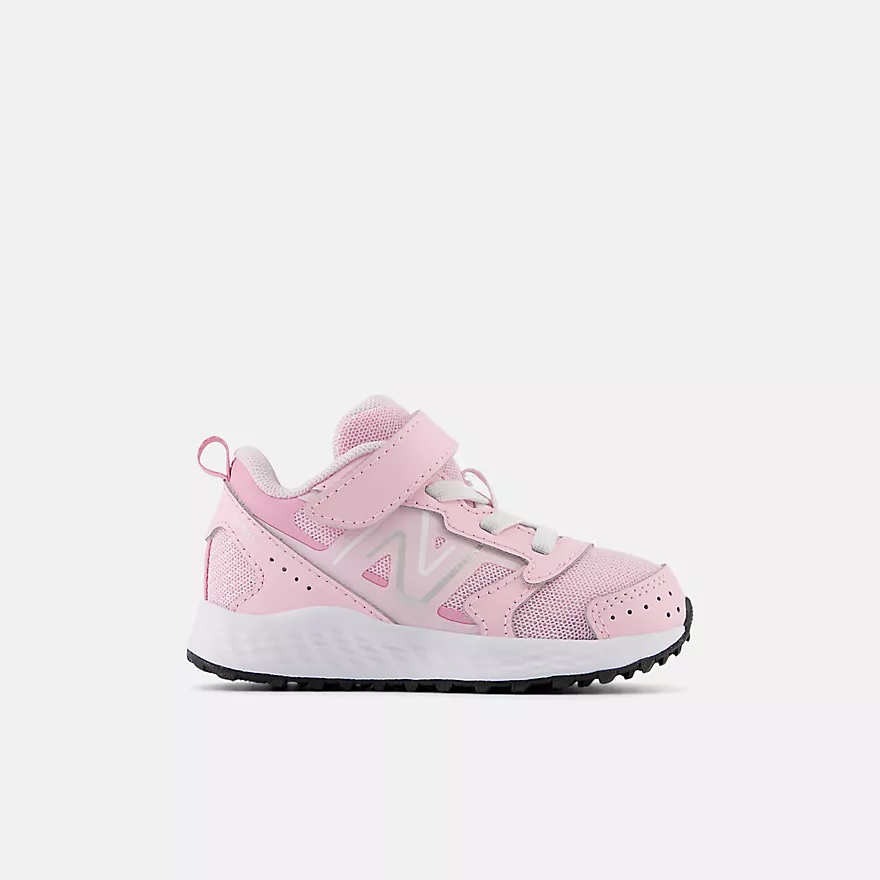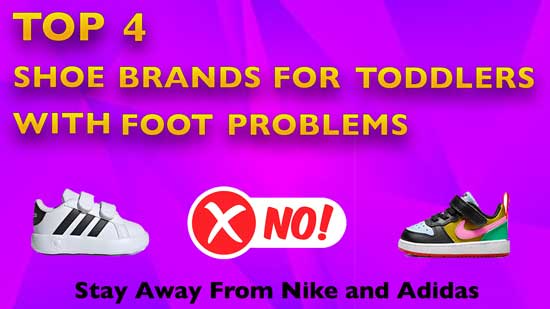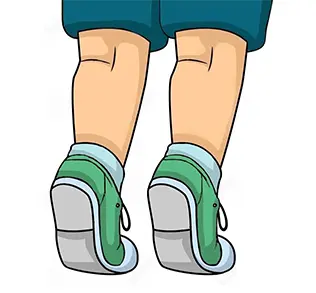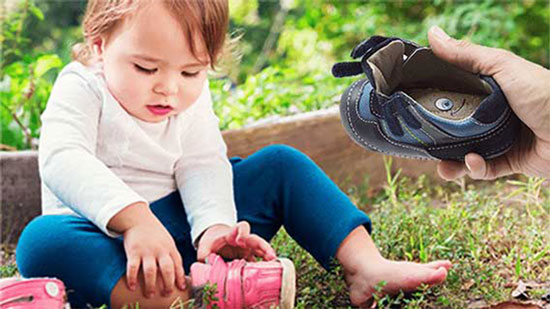The Best Shoes for Toddlers – Learn About the Best Shoe Styles for Your Toddler!

Have you been looking for a pair of supportive, lightweight, and breathable shoes for your toddler? Did you know that the shoes that you choose to provide for your toddler play a key role in keeping their feet and legs healthy? I am going to show you a list of the best shoes for toddlers based on my many years of shoe fitting experience.
There is one important fact you must remember: Toddlers should go barefoot as often as possible to promote healthy foot development, good balance, posture and coordination. However, shoes play a key role in keeping their feet and legs healthy when you start taking them outside.
I have noticed that most toddlers start to walk anywhere between 8 and 18 months of age. That’s an exciting time for every parent, but you need to keep in mind that your toddler’s first walking shoes are critical in form and fit, and they will play a key role in keeping your toddler’s feet and legs healthy.
Most toddlers tend to have wide or extra wide feet, so it’s important that your toddlers’ shoes are capable of fitting the shape of your child’s feet.
What Makes the Shoes I Recommend Ideal for Toddlers?
There are actually 2 other key features that the shoes I recommend provide that makes them the best choice for toddlers:
1️⃣ Extra Depth: This feature allows your toddler’s feet to fit deeply inside the shoes and prevents the top part of your toddler’s feet from rubbing against the top part of the shoes. Shoes that provide extra depth also prevent toddlers from getting blisters on their toes, by preventing the top part of your toddler’s toes from rubbing against the top front part of the shoes. Let me show you the difference between a shoe that provides extra depth and one that doesn’t:
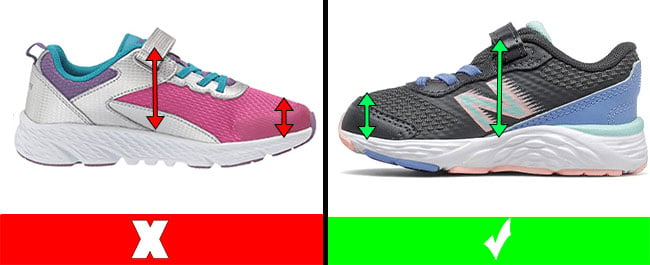
2️⃣ Rounder Toe-Boxes: Shoes with round toe-boxes help prevent your toddler’s toes from rubbing against the side of the shoes or overlapping one another. Let me show you the difference between a pair of shoes that provides a rounder toe-box versus one that doesn’t:
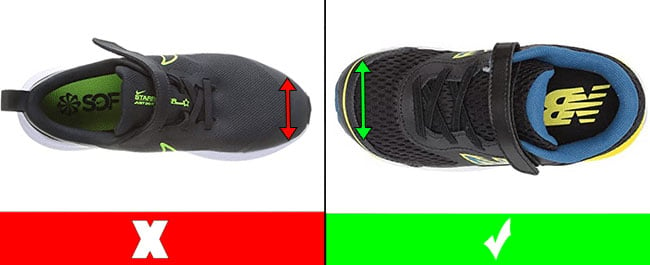
I always recommend parents to take their kids to their local children’s shoe store where a shoe fitter can properly measure their feet and find shoes accordingly. The issue is that most local children’s shoe stores have been closing down, and parents are left with big retailers such as Nordstrom’s or Payless, which have staff who don’t know how to properly fit shoes.
How to Retrieve Your Toddler’s Exact Foot Length and Shape
The reason why I mention this is that I have helped hundreds of children that were experiencing foot and leg pain due to wearing the wrong pair of shoes that were fitted by those stores. I have been contacted by several parents explaining to me how they don’t have a local shoe store in their area and must get their kids’ shoes online. If you are one of those parents, start by reading a post I wrote where I describe the best way to make sure your child is wearing the correct shoe size.
In that article I help parents determine their child’s exact foot size and whether the child has narrow, medium, wide, or extra wide feet. I also will be able to tell you whether your child has a high instep or not.
Before I describe the best shoes for toddlers, I wanted to answer a couple of common questions parents have asked me about their toddler’s feet.
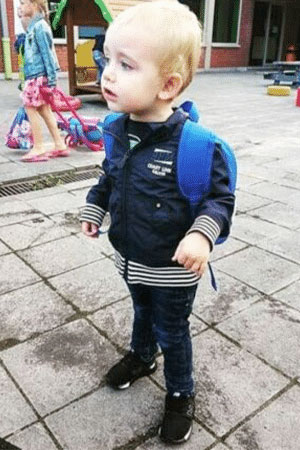
The shoes that you choose for your toddler’s feet play a key role in keeping their feet and legs healthy. Every time a family comes to the shoe store with their toddlers I feel a great responsibility in finding the perfect pair of shoes, because those parents are putting their trust in me.
Without further ado, let’s take a look at the best shoes for toddlers. Disclosure: Some links in this post may be affiliate links and we may receive a small commission (at no extra cost to you) when you click our links and make purchases.
The Best Toddler’s Shoes
These shoes are available in medium (M), wide (W), and extra wide (XW).
Boys
- Shoe style Fresh Foam 650 by New Balance
- Fits toddlers with medium, wide, or extra wide feet
- Oversized opening for easy on and off
- Fresh Foam midsole cushioning is precision engineered to deliver an ultra-cushioned, lightweight ride
- Hook and loop closure
- Order this shoe a whole size larger than your toddler’s current foot size
- Shoe style Ride 10 J by Saucony
- Available in medium, wide, and extra wide widths
- Velcro closure
- Leather and mesh upper for durability and breathability
- APMA Certified
- Traction pods on the outsole for serious grip
- EVA midsole for lightweight feel
- Order this shoe a whole size larger than your toddler’s current foot size
- Shoe style SRT Winslow by Stride Rite
- Available in medium and wide widths
- Toe cap reinforcement and bumptoe protection against stumbles
- Opens super wide which makes in and out easy
- Step-stabilizing design with comfy Ortholite memory foam footbeds
- Order this shoe half a size larger than your toddler’s current foot size
- Shoe style RaveRun by New Balance
- Available in medium, wide and extra wide widths
- Oversized opening for easy on and off
- Lightweight injection-molded EVA foam midsole provides lightweight cushioning
- Hook and loop closure
- Order this shoe a whole size larger than your toddler’s current foot size
- Shoe style Stevie II by See Kai Run
- Fits medium and wide feet (accommodates high insteps)
- Breathable textile lining and cushioned insole
- Hook and loop closure
- Padded tongue and collar for added comfort
- Order this shoe a half size larger than your toddler’s current foot size
- Shoe style 2510 Racer by Tsukihoshi
- Fits medium and wide feet (fits high insteps)
- Hook-and-loop closure
- Removable insoles
- Lightweight and flexible
- Extra wide toe box allows natural splaying of toes for better balance, comfort, and foot health
- Long heel counter provides stability
- Machine washable
- Order this shoe the same size as your toddler’s current foot size (shoe fits long)
- Shoe style Jazz Lite 2.0 by Saucony
- Available in medium and wide widths
- Leather and mesh upper for durability and breathability
- Hook-and-loop strap closure with elastic lace panel
- Anti-stink lining helps reduce odors
- Machine washable for quick and easy clean
- Order this shoe a half size larger than your toddler’s current foot size
- Shoe style 574 New-B by New Balance
- Available in medium, wide, and extra wide widths
- Velcro closure
- Generous toe box and instep to accommodate and support a first-walker’s needs
- Rubber outsole pods designed to stand up to daily wear and tear
- Extra deep
- Order this shoe a whole size larger than your toddler’s current foot size
- Shoe style 574 New-b V1 by New Balance
- Available in medium, wide, and extra wide widths
- Velcro closure
- Generous toe box and instep to accommodate and support a first-walker’s needs
- Rubber outsole pods designed to stand up to daily wear and tear
- Extra deep
- Order this shoe a whole size larger than your toddler’s current foot size
Girls
- Shoe style RaveRun by New Balance
- Fits toddlers with medium, wide, or extra wide feet
- Oversized opening for easy on and off
- Fresh Foam midsole cushioning is precision engineered to deliver an ultra-cushioned, lightweight ride
- Hook and loop closure
- Order this shoe a whole size larger than your toddler’s current foot size
- Shoe style Ride 10 J by Saucony
- Available in medium, wide, and extra wide widths
- Velcro closure
- Leather and mesh upper
- Non-marking traction pods to help improve stability
- APMA approved
- Toe cap for extra durability
- Order this shoe a whole size larger than your toddler’s current foot size
- Shoe style 2510 Racer by Tsukihoshi
- Fits medium and wide feet (fits high insteps)
- Velcro closure
- Heel stabilizer provides lateral stability
- Removable insoles
- The insoles are Infused with natural Green Tea extract (no chemicals)
- Machine washable
- Order this shoe the same size as your toddler’s current foot size (shoe fits long)
- Shoe style 574 NEW-B by New Balance
- Available in medium, wide, and extra wide widths (fits high insteps)
- Hook and loop closure system for easy on and off
- Synthetic/mesh upper
- Fresh Foam midsole cushioning is precision engineered to deliver an ultra-cushioned, lightweight ride
- Order this shoe a half size larger than your child’s current foot size
- Shoe style Stevie II by See Kai Run
- Fits medium and wide feet
- Canvas upper
- Toe cap is durable for early steps
- Double velcro straps
- Oversized opening for easy on and off
- APMA approved
- Order this shoe half a size larger than your toddler’s current foot size
- Shoe style Sr Thompson by Stride Rite
- Available in medium and wide widths
- Ortholite memory foam footbeds
- Opens super wide which makes in and out easy
- Recycled material linings to help reduce odor
- Order this shoe half a size larger than your toddler’s current foot size
- Shoe style RaveRun by New Balance
- Available in medium, wide and extra wide widths
- Oversized opening for easy on and off
- Lightweight injection-molded EVA foam midsole provides lightweight cushioning
- Hook and loop closure
- Order this shoe a whole size larger than your toddler’s current foot size
- Shoe style Kya by See Kai Run
- Fits wide and extra wide feet
- Leather and mesh upper
- Two adjustable hook-and-loop closures for easy on and off
- Padded tongue and collar for added comfort
- APMA approved
- Toe cap for extra durability
- Order this shoe a whole size larger than your toddler’s current foot size
- Shoe style 574 New-b V1 by New Balance
- Available in medium, wide, and extra wide widths
- Velcro closure
- Generous toe box and instep to accommodate and support a first-walker’s needs
- Rubber outsole pods designed to stand up to daily wear and tear
- Extra deep
- Order this shoe a whole size larger than your toddler’s current foot size
- Shoe style Fresh Foam 650 by New Balance
- Available in medium, wide and extra wide widths
- Oversized opening for easy on and off
- No-sew overlays
- Order this shoe a whole size larger than your toddler’s current foot size
Keeping Your Toddler’s Feet Healthy – Don’t Forget About the Socks!
Most parents allow their toddlers to wear their shoes without socks, as toddlers can get pretty fussy about wearing socks. Keep in mind that socks act as a barrier between your toddler’s feet and the shoes, and prevent the buildup of bacteria inside the shoes.
Have you ever heard of seamless socks? They are really important specially if your child can’t stand the feeling of socks, and that feature will also prevent your kids’ toes from overlapping each other, this is also really important specially if your child has wide or extra wide feet. If you have a child that refuses to wear socks because he/she feels every lump and bump, you should also take a look at another post I wrote where I describe the best seamless socks for kids.
What Features Must a Good Shoe Provide? – Support and Stability!
There are the most important features that the shoes I recommended provide:
1️⃣ Support: The shoes are lightweight and flexible, but at the same time supportive to minimize the impact their feet receive every time they become in contact with the ground.
2️⃣ Firm heel counter: This feature provides your toddler with good ankle support. This is especially important for toddlers as most of the time they are performing lateral movements.
3️⃣ Lightweight/Flexible: The shoes are lightweight and flexible for your child’s feet and legs to not become tired easily.
4️⃣ Traction: This is also really important since you don’t want your toddlers slipping and falling, especially when they are walking around slippery surfaces.
5️⃣ Breathable: To prevent the build of bacteria and prevent foot odor, the shoes must be breathable.
Now that you know about the importance of properly fitted shoes and socks, you are ready to make the most informed decision.
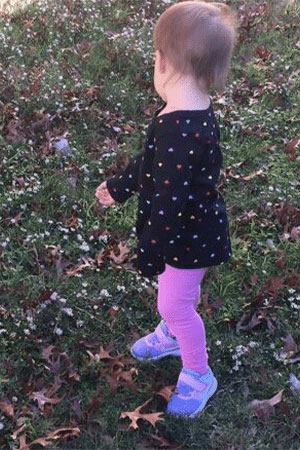
Are You Worried About Your Toddler’s Feet?
One common question parents have when it comes to their toddler’s feet is whether they have flat feet or not.
That most toddlers are flat-footed when they first start walking. Most of them tend to turn their feet inwards, because muscle strength and ligament stiffness need to catch up to other development. However, the flat-footedness nearly always improves as they keep growing up.
Let’s check out some of the symptoms you must take into consideration if you are worried about your toddler’s feet or walking gait. Problematic symptoms may include:
- The toddler complains of pain while walking.
- Ingrown toenails (that persist or are painful).
- Bunions or other deformities.
- Stiffness in the foot.
- Severe in-toeing or out-toeing.
- Flat feet beyond the age of five years.
- If your child isn’t walking at all by two years of age.
But, we don’t have to worry about that now. However, if you think your child might be a candidate for orthotics, start by reading a post I wrote where I describe the best orthotics for toddlers with flat feet.
Are Any Other Shoe Choices Available?
Do not hesitate to contact me directly via my e-mail if you have any further questions or if you need a different pair of shoes for your toddler. My e-mail address is:
Have you found a particular shoe style for your toddler that has worked well for his or her feet? Please share your findings below so other families can benefit from your experiences.




